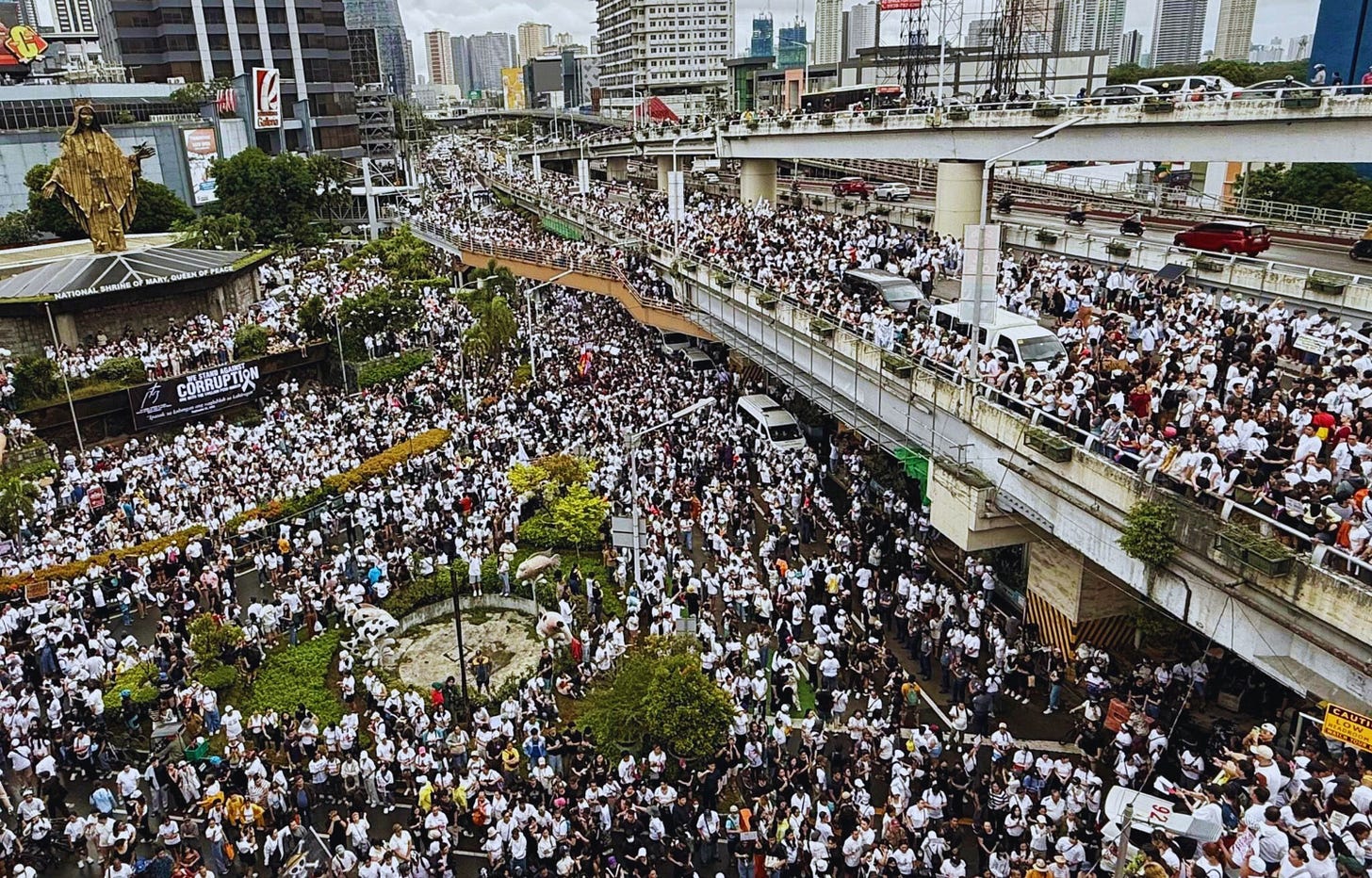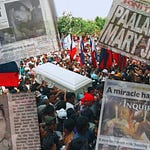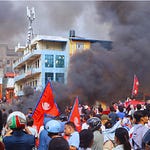
For perspective, 1.9 trillion pesos — the amount the Philippine government has ostensibly spent on flood-control measures over the past 15 years — is equivalent to around 33 billion US dollars. Of this, more than half is alleged to have been siphoned away through corruption.
Since September, following a series of huge nationwide demonstrations dubbed the Trillion Peso March, Filipinos have been regularly taking to the streets en masse to protest the rampant corruption they say continues to plague their country. For many, revelations of just how much public funding has been diverted from crucial flood-prevention and mitigation projects are seen as representative of a deep rot at the heart of Philippine politics.
An archipelagic nation made up of more than 7,600 islands, the Philippines faces the Pacific Ocean directly to its east, with the next major land masses (North and South America) lying roughly 8,000 miles away. This makes the country acutely vulnerable to extreme weather events that form over the ocean, such as typhoons and tropical storms, which have intensified in recent years due to climate change. These natural disasters hit regularly and severely, causing wide-scale flooding, death, destruction and displacement.
“[Victims of the floods] couldn’t sleep anymore at night whenever there’s a typhoon coming,” says Jean Enriquez, Executive Director of the Coalition Against Trafficking in Women – Asia Pacific. “Because they’re expecting the water to rise very quickly, and they have to ensure that their children, who are often sleeping on the floor — and I’m talking about our grassroots communities, within the informal settlers areas and even the rural areas — they have to pick up their children […] so they won’t be drowned.”
It’s easy to understand why so many Filipinos consider flood control and mitigation as one of the most urgent issues facing their country — and why corruption that stalls or derails this work has become a focal point of public anger.
“There’s lot of projects that have been declared completed when in fact they were never even started. These are the so-called ‘ghost projects’,” says Josua Mata, Secretary General of labour rights group, SENTRO. “You even have a situation where the main watchdog of the government — COA, the Commission on Audit — [in] practice is given one percent of the cut.”
Corruption and Poverty
When Pope Francis visited the Philippines in 2015, he chose his official welcoming ceremony to urge politicians in the overwhelmingly Catholic nation to “reject every form of corruption, which diverts resources from the poor, and to make concerted efforts to ensure the inclusion of every man and woman and child.”
More than 10 years on — and despite this plea from the Church’s highest authority — not a whole lot seems to have changed.
On paper, poverty levels have been falling: according to the Philippine Statistics Authority, the number of Filipinos living below the poverty line dropped to 15.5% last year, down from 18.1% in 2021.
But statistics don’t necessarily reflect on-the-ground realities. One only has to travel around Metro Manila to see the stark juxtaposition between the very wealthy and the ultra-poor. Gated communities and newly built high-rise condominiums are often situated barely a few metres away from slums that lack basic utilities, the two usually separated by imposing brick walls topped with razor wire.
Beyond this, a recent survey found that around half of the population of the Philippines consider themselves to be poor, pointing to broader socioeconomic distress and widening inequality, where millions lack access to essential services. As a commentary piece in the Philippine Daily Inquirer from earlier this year puts it:
The reality of poverty in the Philippines isn’t just reflected in the numbers but also in lived experiences. Multidimensional poverty, which includes a lack of access to basic needs such as food, clean water, education, and health care, affects 18 percent of the global population—a number mirrored in many Filipino communities. For these people, poverty is not just about income; it is about survival in a society where opportunities to improve one’s quality of life are often out of reach.
The Philippines is far from the only country in the Asia-Pacific region grappling with these issues. As such, it’s no surprise that high-profile, obstreperous movements protesting inequality, corruption and government mismanagement elsewhere have resonated deeply with many Filipinos.
In Indonesia, protests intensified in late August after a police vehicle ran over and killed a motorbike-taxi driver. The public anger and mass demonstrations that followed shook the Indonesian political establishment: politicians homes were ransacked, government buildings and police stations were burned down, and the government scrambled to show its riled-up citizenry that action was being taken by promising reforms.
The outcome of Nepal’s so-called ‘Gen Z protests’, which erupted shortly after the movement in Indonesia peaked, was even more consequential. On September 8, police fired live rounds into crowds in Kathmandu, killing at least 19 people and wounding dozens more. Demonstrations quickly escalated into a full-blown revolution, and by the following day protesters had stormed and torched the parliament, toppling the government.
While neither country has seen ideal outcomes (flare-ups and state clampdowns have continued in both Indonesia and Nepal), many in the Philippines have been looking to these uprisings for inspiration in their own movement. But the dynamics of Philippine politics present their own unique challenges.
The Political Fall Out
No discussion of current-day political and social developments in the Philippines would be complete without Rodrigo Duterte’s name being mentioned sooner or later.
Duterte, who served as the Philippine president from 2016 to 2022, is currently on trial at the International Criminal Court (ICC) in The Hague for crimes against humanity related to his administration’s brutal drug war. Official figures estimate around 6,000 people were killed during his tenure, though some human rights groups place the number upwards of 30,000.
Despite the widespread violence, increased restrictions on civil liberties and multiple allegations of corruption that took place under his rule, Duterte remains a powerful figure in the Philippines — both popular with large swathes of the public, and influential in national politics. Having risen to prominence as mayor of his hometown, Davao City, and then assuming the presidency, he has now established himself as the head of a political dynasty: his daughter, Sara, currently serves as vice president, with his youngest son serving as acting mayor and his grandson as acting vice mayor of Davao City. (Although Rodrigo Duterte is officially the incumbent mayor, this is all-but in name while he awaits trial in Brussels.)
But the prominence of the Dutertes seems to have triggered a rupture with a more old-school political clan: the Marcos family.
After ruling the Philippines under martial law from the 1970s to early 1980s, the infamously despotic and kleptocratic Ferdinand Marcos Sr. was ousted as president in 1986 following a series of mass demonstrations known as the People Power Revolution. The Marcoses fled into exile then, but have since spent decades working vigorously to rehabilitate their image and revive their political fortunes. Their efforts ultimately paid off, culminating in Ferdinand “Bongbong” Marcos Jr. being elected president in 2022.
Over the past year or so, speculation has grown about a major falling out between the Marcoses and the Dutertes, underscored by a series of political developments. In February, the lower house of parliament voted to impeach Sara Duterte over allegations including the misappropriation of funds, and assassination threats against the president and first lady. About a month later, her father was arrested and extradited to Brussels — a move that almost certainly required political approval at the highest level. (However, in July the Supreme Court ruled that the impeachment of the vice president was unconstitutional, preventing Sara Duterte’s case from going to trial.)
Many anti-corruption activists and protest organisers now worry that Duterte loyalists are attempting to hijack the Trillion Peso movement and weaponise the widespread public discontent as a means to topple the Marcos government, thereby re-establishing the Dutertes as the dominant power bloc in Philippine politics.
“At the same time the Marcoses are trying to use this [unrest] to attack their main enemy, which is the Duterte camp,” says Josua. “So that’s where the labour movement, the women’s movement, and all the civil society movements comes into the picture — we need to [encourage people to think] that this is not about protecting Duterte, but this is about advancing people’s rights and interests.”
In This Episode
As the country gears up for the second round of the Trillion Peso March, planned for November 30, this edition of Currents is the first part in a short series examining the developing situation in the Philippines. In this episode, I speak with Jean and Josua — both of whom have been involved in organising recent rallies and demonstrations — about the protests, the issues that have brought people onto the streets, and where it all might lead.
For additional background on some of the topics discussed here, you can listen to my two-part conversation with human rights lawyer, Cathy Alvarez, and the former Commissioner at the Philippines’ Commission on Human Rights, Karen Gomez-Dumpit, on their reactions to the arrest and extradition of Rodrigo Duterte earlier this year (Part 1 and Part 2).
For more information about protest movements which have taken place in other countries, you can listen to my interviews with Andreas Harsono from Human Rights Watch discussing the anti-corruption protests that swept across Indonesia, and with independent journalist Pranaya Rana on the fallout of the Gen Z movement in Nepal.











